Bryan L. Programmable controllers. Theory and implementation
Подождите немного. Документ загружается.


739
CHAPTER
15
Process Controllers
and Loop Tuning
SECTION
4
PLC Process
Applications
Industrial Text & Video Company 1-800-752-8398
www.industrialtext.com
purposes of obtaining an equation for the best controller to govern this system,
the delay can be omitted during the initial controller calculations. However,
we should remember that there is a dead time response in the system.
The A term in the second-order system transfer function indicates the process
gain and the τ
1
and τ
2
terms are the two lag times (see Figure 15-65). This
second-order system is said to be inclusive of a first-order system, meaning
that if one of the lag times is zero, the second-order equation will represent a
first-order system. The ideal transfer function of a perfect process control
system (
PV
SP
) should equal one, indicating that the output of the process (PV)
immediately follows any changes in the set point without requiring negative
feedback to correct the error since there is no error. In other words, if there is
a step change in the set point from 0 to 1, the process will respond immediately
with a change from 0 to 1. The controller-process relationship in a perfect
system is such that they complement each other perfectly. Therefore, the
transfer function of the process variable over the set point will be one. Accord-
ingly, the equation for a perfect open-loop system is (see Figure 15-66):
PV
SP
Hc Hp
s
s
ss
()
()
() ()
==1
Figure 15-65. Second-order system.
Figure 15-66. Perfect open-loop system.
Hp
(
s
)
=
=
Hc
(
s
)
Hp
(
s
)
E
PVCV
SP
+
–
Σ
PV
PV
(
s
)
CV
(
s
)
Hc
(
s
)
=
CV
(
s
)
E
(
s
)
Ae
–t
d
s
(τ
1
s
+1)(τ
1
s
+1)
=
(
e
–t
d
s
)
A
(τ
1
s
+1)(τ
1
s
+2)
Hp
(
s
)
Hc
(
s
)
SP
PV
=
Hc
(
s
)
Hp
(
s
)
= 1
PV
(
s
)
SP
(
s
)
1
0
11
0
t
d
e
–t
d
s
delay

740
SECTION
4
PLC Process
Applications
Industrial Text & Video Company 1-800-752-8398
www.industrialtext.com
CHAPTER
15
Process Controllers
and Loop Tuning
So, for a perfect system, the controller’s transfer function should be the
inverse of the processor’s transfer function. Therefore, the controller’s
transfer function in a perfect system using a typical process approximation
is:
Hc
Hp
A
ss
A
sss
A
ss
s
s
A
ss
()
()
()()
=
=
()
=
+
()
+
()
=
+++
()
=
++
()
+
[]
++
1
1
1
11
1
1
1
1
12
11
12
12
2
12
12
2
12
ττ
ττ
ττ τ τ
ττ τ τ
The term
1
A
is a constant; therefore, it can be renamed as A
1
:
Hc A s s
s()
=++
()
+
[]
112
2
12
1
ττ τ τ
Dividing each term in the bracket by s yields:
Hc A
s
s
s
ss
As
s
s()
=+
+
()
+
=++
()
+
1
12
2
12
112 1 2
1
1
ττ
ττ
ττ τ τ
Multiplying the A
1
term and rearranging the equation produces:
Hc A
A
s
As
s()
=+
()
++
11 2
1
112
ττ ττ
P
I
D
12434
{
123
The terms in this equation indicate that the controller has a proportional
gain, an integral action (
1
s
), and a derivative component (s). Therefore, the
perfect system controller exhibits proportional, integral, and derivative
actions. Note that the constant gain term in this equation does not imply that
the gains should be the same for each of the PID actions. Rather, it indicates
that these gains must be present and specified. Because a PID-type controller
is the natural derivation from a perfect system, PID is considered a universal
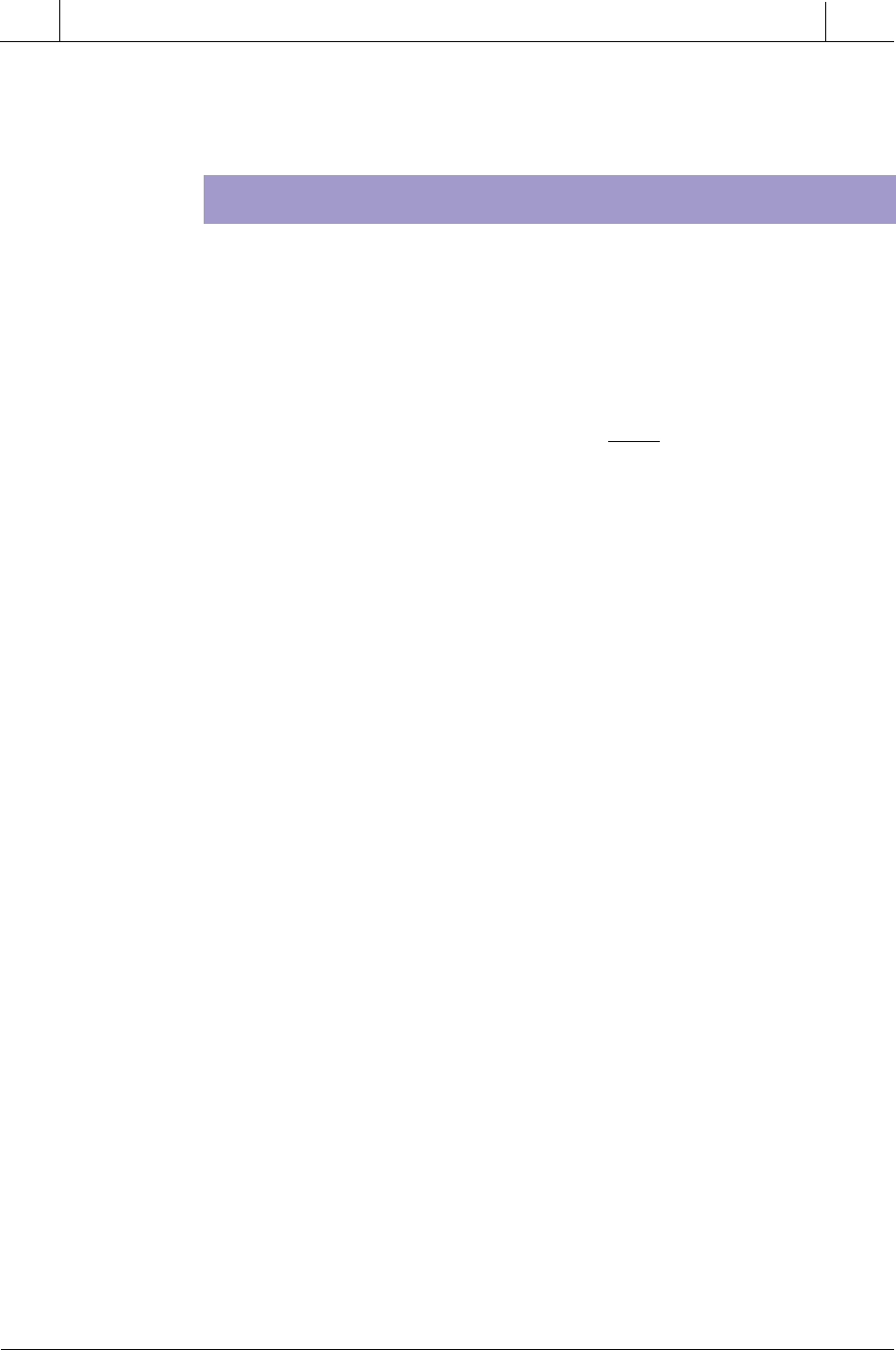
741
CHAPTER
15
Process Controllers
and Loop Tuning
SECTION
4
PLC Process
Applications
Industrial Text & Video Company 1-800-752-8398
www.industrialtext.com
type of control for manufacturing processes. In fact, of all the PID configu-
rations shown in Figure 15-64, perhaps the most commonly used in PLCs is
the serial, modified derivative, PID configuration.
DIGITAL IMPLEMENTATION OF PID IN A PLC
A programmable controller system implements the PID control action
using a discrete, or digital, algorithm to update the control variable (CV).
For example, a modified serial PID controller may use the following
digital algorithm, where the current control variable output (CV
n
) is repre-
sented as:
CV CV K E E K K TE
KK
T
PV PV PV
nn Pnn PIsn
PD
s
nn n
=+−+ − − +
−− −−
()
()
() () () ()11 12
2
where:
CV n
CV n
K
K
K
En
En
T
PV n
n
n
P
I
D
n
n
s
n
=
=
=
=
=
=
=
=
=
−
−
the controller output at the th update
the controller output at the th minus one update
the proportional gain (in seconds, where appropriate)
the integral gain (in seconds, where appropriate)
the derivative gain (in seconds, where appropriate)
the error at the th update
the error at the th minus one update
the loop sample time in seconds
the process variable at the th
()
()
1
1
updateupdate
the process variable at the th minus one update
the process variable at the th minus two update
PV n
PV n
n
n
()
()
−
−
=
=
1
2
The loop sample time (T
s
) is the frequency of how often the PLC reads and
executes the integration and derivative terms in the algorithm equation. In
PLCs, this time can be selected from a range of 0.1 seconds to several hundred
seconds (e.g., 600 seconds, or 10 minutes) Figure 15-67 illustrates several
sampling rates. A small value of T
s
(fast update time) is desirable in a process
application where the process variable responds rapidly to control variable
changes. However, because large values of T
s
are necessary to evoke a stable
derivative action, the trade-off between a low and high T
s
value must be
balanced carefully to ensure a correct system response. Otherwise, the
derivative action can produce a bumpy action.

742
SECTION
4
PLC Process
Applications
Industrial Text & Video Company 1-800-752-8398
www.industrialtext.com
CHAPTER
15
Process Controllers
and Loop Tuning
The digital PID algorithm implemented in PLC systems calculates the error
by approximating the area between the process variable and the set point (see
Figure 15-68). This area calculation provides an approximate value of error.
Figure 15-68. Error approximation using loop sample times.
Figure 15-67. Loop sample rates.
PV
SP
t
t
0
t
1
t
2
t
3
t
4
t
5
t
6
t
7
t
8
t
9
t
10
t
11
Update or Sampling Points
Error is approximated by
the shaded sampled area
PV
SP
t
PV
SP
t
PV
SP
t
T
s
T
s
T
s
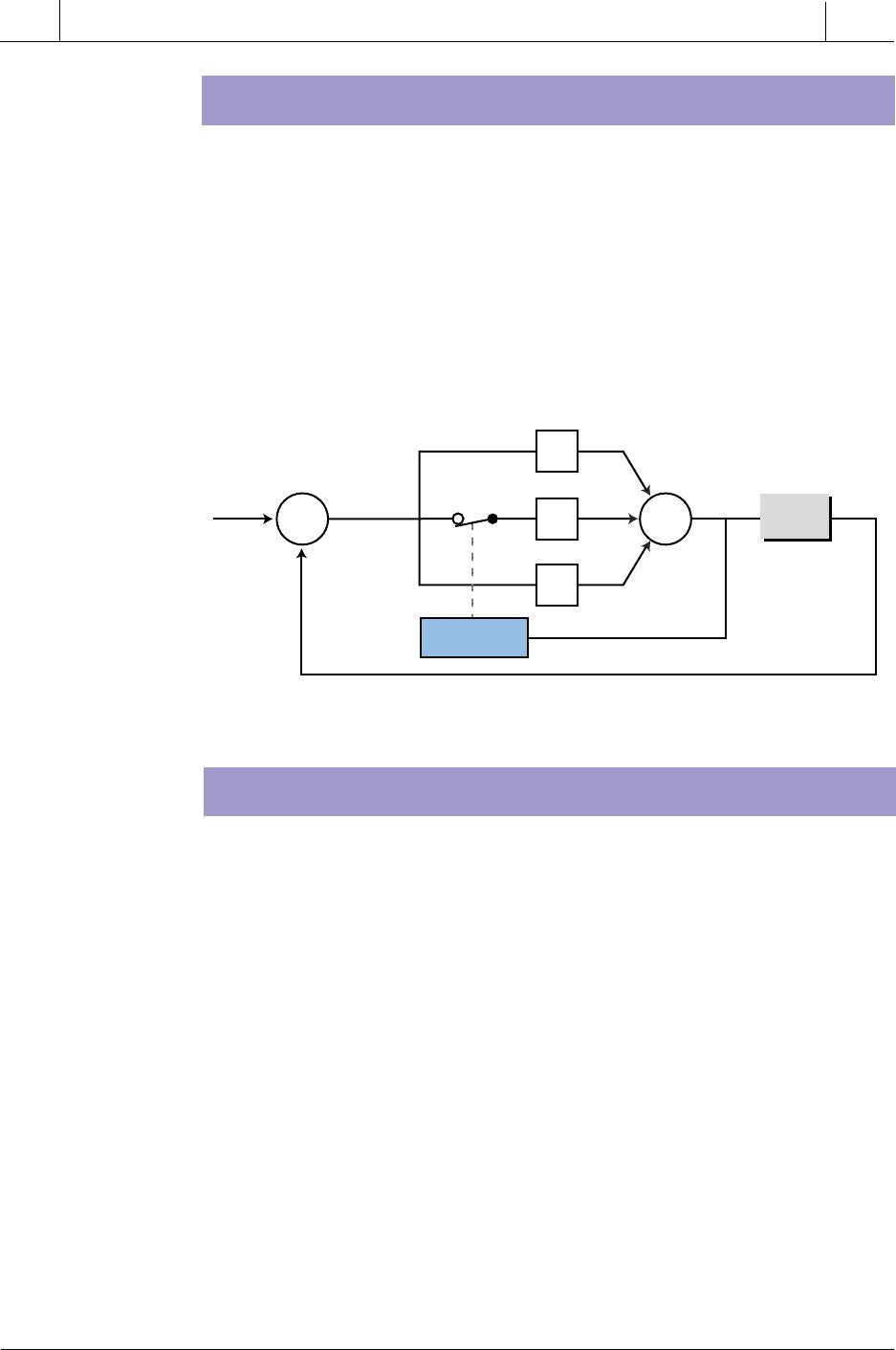
743
CHAPTER
15
Process Controllers
and Loop Tuning
SECTION
4
PLC Process
Applications
Industrial Text & Video Company 1-800-752-8398
www.industrialtext.com
INTEGRAL (RESET) WINDUP
As discussed in Section 15-7, integral (or reset) windup is a problematic
condition that occurs in PI and PID controllers, resulting in the saturation of
the controller’s output (CV = CV
max
). Integral windup is typical in startup
situations during batch processes. To avoid integral windup, some PLC
manufacturers offer PID interfaces that prevent integral action when the
controller’s output reaches 100%. These interfaces accomplish this by
forcing the error input to the integrator section of the PID controller to zero.
The block diagram in Figure 15-69 illustrates this method of integral windup
prevention.
Figure 15-69. PID controller with integral windup prevention.
PID BUMPLESS AUTO/MANUAL TRANSFER
Most PLC applications that implement PID control employ automatic/
manual control stations that allow the operator to switch between manual and
PLC process control. To prevent a step change or “bump” during this switch,
the control station must ensure that both controllers, the manual controller and
the PLC (automatic), send the same output (CV) to the process. Otherwise, the
process may receive a change in the control variable, which could produce a
transient response in the system.
Figure 15-70 illustrates a PLC system that uses a PID controller interface
with a manual control station that allows for bumpless transfer. Basically,
the automatic (PLC) and manual controllers must follow each others
outputs when they are operating. Figure 15-71 illustrates this configuration
in block diagram form for a modified serial PID controller. When the system
is in manual mode, the PID controller tracks the manual controller’s output,
so that when the transfer from manual to automatic occurs, both controller
outputs are the same. A similar operation takes place during an automatic-to-
manual transfer.
Hp
E
PVCV
SP
+
+
+
+
–
Σ
Σ
PV
D
I
P
CV
=
CV
max

744
SECTION
4
PLC Process
Applications
Industrial Text & Video Company 1-800-752-8398
www.industrialtext.com
CHAPTER
15
Process Controllers
and Loop Tuning
During a manual-to-automatic transfer in a PLC system, the PID interface
processor may also set the set point equal to the process variable. This forces
the system error (SP – PV) to zero, ensuring that a bump does not occur
during the transfer. The control variable output of the PLC controller, which
tracks the manual CV output, is left unchanged during the transfer. After the
transfer, the PID processor returns the set point to its original value.
15-11 ADVANCED CONTROL SYSTEMS
CASCADE CONTROL
Figure 15-70. PID interface with a manual control station for bumpless transfer.
Figure 15-71. Auto/manual control station block diagram.
Block Transfer
PID
Module
ProcessorPower
Supply
Manual Request
Analog Output (
CV
)
Tieback Input
Analog Input (
PV
)
Man/Auto Status
Optional user-
supplied manual
control station
P
r
o
c
e
s
s
Cascade control uses two controllers configured so that the output of one
feedback loop becomes the set point for the other one. Figure 15-72a
illustrates a temperature control batch system that utilizes a single PID
controller, while Figure 15-72b shows the same system with cascade
While conventional PID control provides universal control for most pro-
cesses, other techniques can increase the performance of a process control
system. One of the most commonly practiced techniques used to increase
process control performance is cascade control.
Hp
E
PV
SP
+
–
Σ
PV
Auto
Auto
Auto
Man
Man
Man
Auto
Hc
PID
Manual
Hc
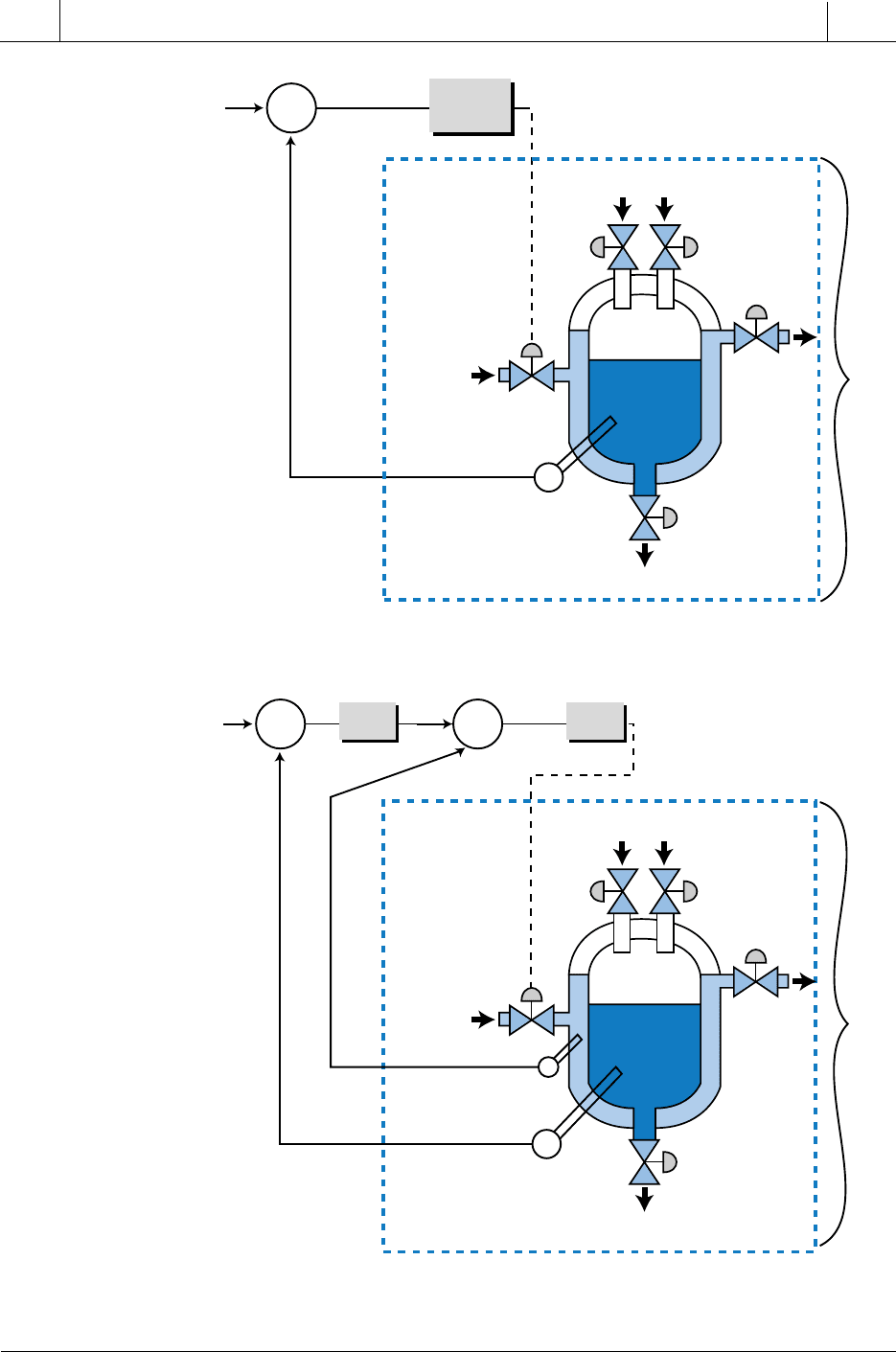
745
CHAPTER
15
Process Controllers
and Loop Tuning
SECTION
4
PLC Process
Applications
Industrial Text & Video Company 1-800-752-8398
www.industrialtext.com
Figure 15-72. Temperature control systems with (a) single and (b) cascaded PID controllers.
(a)
(b)
Hc
E = SP – PV CV
PV
SP
+
–
Σ
Steam
Batch
Temperature
Sensor
Product Discharge
Steam
Return
Material 1 Material 2
Hp
Steam
Product Discharge
Steam
Return
Material 1 Material 2
Hc
1
Hc
2
E
1
E
2
PV
1
PV
2
SP
+
–
Σ
+
–
Σ
Batch
Temperature
Sensor
Jacket
Temperature
Sensor
Batch Tank
Controller
Steam Jacket
Controller
Steam
Jacket
SP
Hp

746
SECTION
4
PLC Process
Applications
Industrial Text & Video Company 1-800-752-8398
www.industrialtext.com
CHAPTER
15
Process Controllers
and Loop Tuning
control. In the cascade configuration, the batch tank controller provides the
set point for the steam jacket temperature controller, which in turn, actuates
the steam valve. The batch tank loop is called the primary loop, since the
main process variable (the batch temperature) is the primary control concern
(see Figure 15-73). The steam jacket temperature loop is called the second-
ary loop, or inner loop, since the jacket temperature is of secondary interest
in the control system.
Figure 15-73. Primary and secondary loops of the temperature control system.
Hc
1
E
PV
PV
SP
+
–
Σ
+
–
Σ
Steam
Jacket
Temp
Batch
Tank
Temp
Steam
Jacket
SP
Steam Jacket
Valve
Batch Tank
Process
Secondary (Inner) Loop
Primary Loop
Hc
2
Hp
2
Hp
1
The greatest advantage of cascade control systems, and in fact the main reason
for their use, is that they respond quicker than single-controller systems to
disturbances that affect the primary loop. In cascade control, the secondary
loop response to a disturbance generally occurs first, before the primary loop
starts to respond. In the batch system shown in Figure 15-72b, a change in
steam temperature will affect the tank’s jacket temperature before it affects
the main batch temperature due to the lag and dead times associated with the
batch process. The steam jacket secondary control loop will respond first to
this disturbance and try to correct it, thus minimizing the effect of the
disturbance on the main batch system. This fast response of the secondary
loop enhances the performance of cascaded control systems as compared to
single-loop control systems.
Most programmable controller systems allow cascade control directly to
the PID intelligent interface or analog input modules (if PID is imple-
mented in the main PLC processor). Therefore, the user must only identify
the input to the secondary loop (see Figure 15-74). The secondary loop
cascade input is also referred to as the remote input in conventional, single-
loop controllers.
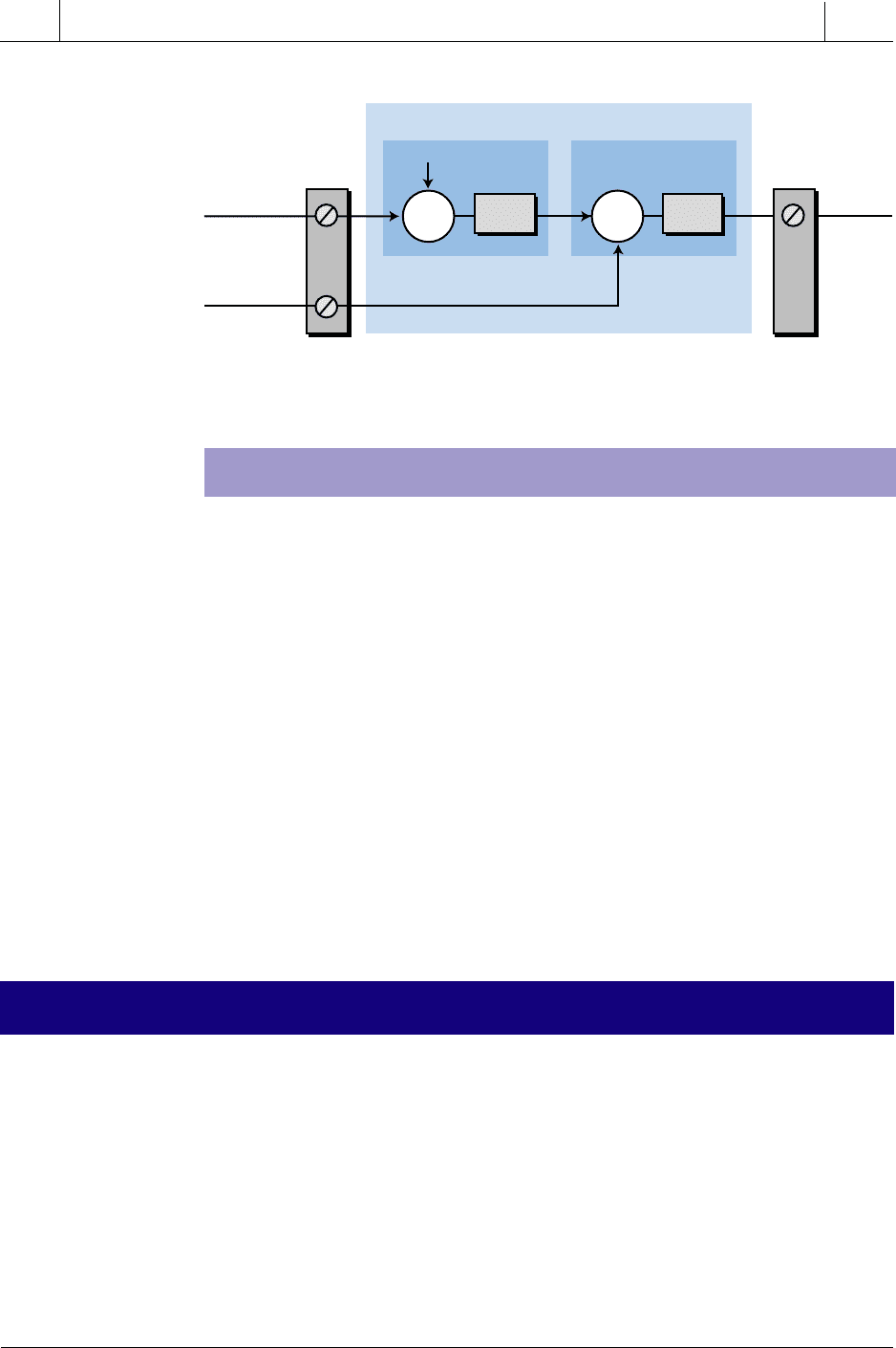
747
CHAPTER
15
Process Controllers
and Loop Tuning
SECTION
4
PLC Process
Applications
Industrial Text & Video Company 1-800-752-8398
www.industrialtext.com
Figure 15-74. Cascade control directly to a PID interface.
BUMPLESS CASCADE CONTROL
PLC systems also provide bumpless transfer in cascade control configura-
tions. Most often, the transfer sequence from manual to automatic is initiated
in the secondary loop (see Figure 15-75). Once the secondary loop is placed
in automatic mode, the secondary loop set point is set to the value of the
secondary process variable PV
2
. Then, the primary loop is placed in automatic
mode and the primary loop set point is set to the value of the primary process
variable PV. The primary loop’s output is left unchanged. This is the initial
operation that avoids a bump. From there, the primary loop’s set point returns
to the desired value, and the primary’s output adjusts the set point of the
secondary loop controller. In general, the primary loop cannot be activated
unless the secondary loop is already active or in the AUTO mode.
The tuning of cascade controllers, which we’ll explain in the next section,
must be performed in a sequential, logical fashion. In most systems, the user
must tune the secondary loop first, with the primary loop in manual mode.
After the secondary loop is tuned, the tuning of the primary loop can begin.
15-12 CONTROLLER LOOP TUNING
For a process control system to work correctly, its control loop(s) must be
tuned. Loop tuning involves selecting the constants [K
P
, K
I
(or T
I
), and K
D
(or T
D
)] that will be used with the proportional, integral, and derivative actions
of a controller. With these constants at the proper levels, the controller can
effectively and efficiently regulate the process variable to the set point.
A process often experiences disturbances caused by changes in the set point
or the process load (see Figure 15-76). These disturbances cause an error in
the system, thereby changing the controller output, which in turn, impacts
Hc
1
Hc
2
SP
1
+
–
Σ
+
–
Σ
PID
1
PV
1
Primary
Loop
CV
To
control
element
PV
2
Secondary
Loop
(Remote Input)
SP
2
PID
2
PID Loop 1 PID Loop 2
PID Interface
Analog
Input
Analog
Output
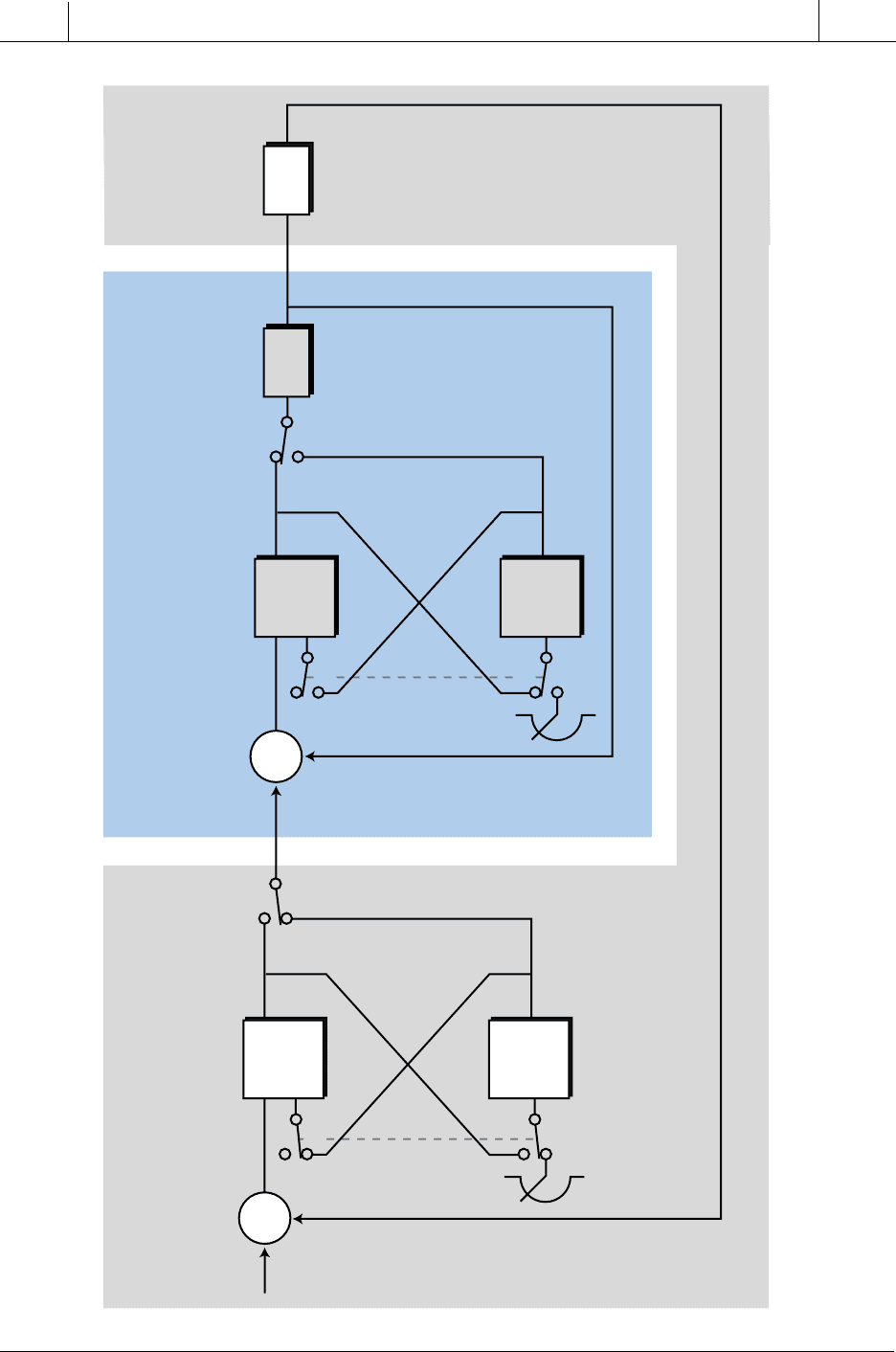
748
SECTION
4
PLC Process
Applications
Industrial Text & Video Company 1-800-752-8398
www.industrialtext.com
CHAPTER
15
Process Controllers
and Loop Tuning
Figure 15-75. Bumpless transfer in cascaded PID controllers.
Hp
2
Hp
1
ESP
+
–
Σ
PV
1
Auto
Auto
Man
Auto
Man
Auto
Hc
1
PID
Manual
Hc
1
ESP
+
–
Σ
PV
2
PV
2
PV
1
Auto
Auto
Man
Auto
Hc
2
PID
Manual
Hc
2
Primary loop in manual.
After secondary is in auto, then
transfer from manual to auto.
Secondary loop transfer
from manual to auto
Man
Man
Man
Auto
